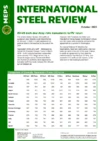Ukraine production uptick highlights supply sensitivity
MEPS respondents in Poland are growing increasingly concerned about the potential effects of oversupply as steelmakers in Ukraine increase production.
Some believe that the risks faced by cargo ships leaving Ukrainian ports, as a consequence of the ongoing conflict with Russia, are increasing Poland’s exposure to cross-border exports by road and rail.
Awareness of the influence of Ukrainian exports may have been heightened by the border blockade established by Poland’s farmers in November last year. The action followed farmers’ complaints of unfair competition, and affected the delivery of agricultural and steel cargoes, but was eventually ended in January.
Demand for flat and long steel products remained weak in Poland, during MEPS’s latest research period. Steel prices remain stable and MEPS respondents say that stockists and service centres are battling the effect of low margins. Consequently, any upturn in supply is increasingly viewed negatively, as a potential source of further downward price pressure.
Battle to retain production capacity
Ukraine’s crude steel production declined by over 70% year-on-year, to 6.26 million tonnes (from 21.4m), in 2022. This was despite 1.85m tonnes of production during January and an output of 1.55m tonnes in February – the month of the Russian invasion.
In 2023, production declined by 0.6%, to 6.23m tonnes. Disruption to energy supplies and the effects of shelling both affected steelmaking activity last year. Meanwhile, production at ArcelorMittal’s Kryvyi Rih operation was disrupted after a series of explosions resulted in the breach of the nearby Kakhovka reservoir – cutting the site’s water supply.
In March this year, Ukraine’s crude steel production rose by 15.8% year-on-year and 14.9% month-on-month to 610,900 tonnes. This was its highest level since February 2022.
Ukraine’s hot rolled coil exports remain significantly down on the 3.89m tonnes annual total of pre-war 2021, however. Last year, they totalled 911,681, down by 21% year-on-year. Nonetheless, the 346,796 tonnes exported from the country in quarter one of this year is almost three times greater than during the same period 12 months ago, according to data from worldsteel.
March alone brought a 200% year-on-year increase in exports, to 125,601 tonnes (from 41,853), with over 50% of exports destined for Poland.
Efforts to improve export logistics
The option of wider export opportunities may bring benefits to Ukraine’s steelmakers and ease the supply concerns of steel businesses in Poland. In an April address at the US-Ukraine Partnership Forum 2024, Ukraine’s deputy prime minister for recovery, Oleksandr Kubrakov, said that work was ongoing to ensure that “Ukrainian exports get to global markets”.
Efforts are being made to establish new and expanded border crossings along the country’s western border. Furthermore, the US Export-Import Bank has preliminarily approved a USD156.6m loan for the purchase of 40 diesel locomotives for Ukrainian Railways.
Nonetheless, logistical issues will remain a key factor in Ukraine’s steel production volumes in the future. Capacity will continue to be affected by issues outside the control of steelmakers. A long-awaited recovery in demand is likely to prove the real catalyst required for steel price rises, both in Central Europe and further afield.

Source:
International Steel Review
The MEPS International Steel Review is an essential monthly publication, offering professional analysis and insight into carbon steel prices around the world.
Go to productRequest a free publication





